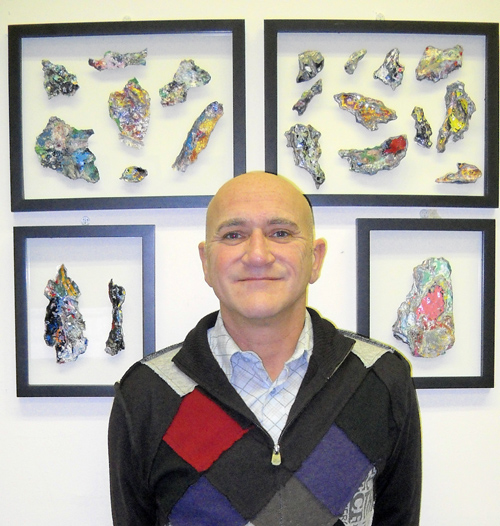
For decades, groups of “artists” have painted the campus cannon in Branion Plaza. Now a staff member armed with a camera and a bit of imagination has exposed an unlooked-for kind of artwork in Old Jeremiah.
Call it “artillery art.” Or “cannon art,” as Peter Wolf dubs his project.
As with many members of campus, he was intrigued two years ago when MFA student Dawn Johnston took about a week to scrape and chisel away decades’ worth of accumulated paint layers from the field-piece-turned-message-board.
He collected some of the multicoloured strips – some an inch or more thick – to take home. “I was fascinated by the material,” says Wolf, director of the Centre for Open Learning and Educational Support.
After cleaning the pieces, he used a tool to expose the paint layers and then applied varnish. He’s mounted several dozen samples behind glass on frames now adorning his Johnston Hall office.
Experimenting last fall with a new camera lens, he took dozens of close-up photos of his collection. Under that macro eye, those ordinary paint chips become surreal landscapes, all swirls and whorls and splotches of colour, like the work of a topographical mapmaker gone mad (http://www.flickr.com/photos/34285071@N07/sets/72157632058990948/).
That metaphor is evident to geography professor Alice Hovorka, Wolf’s partner. “As a geographer, I see both a cultural landscape – one that symbolically represents years of student engagement at U of G – and a natural one, where topographical contours emerge from the material layers of paint. Metaphors all ’round.”
“These are definitely abstracts,” says Wolf, who favours work by Picasso and Miró. Mostly, his “cannon shots” remind him of the bright, colourful splotches in Alt Otmar’s poster for the 1972 Olympics that hung in his boyhood room in Montreal.
He has used his paint photos to make greeting cards. He likes stumping recipients trying to guess where the designs came from. “People have no idea.”
Wolf wonders what other campus members have done with their salvaged paint samples. “Perhaps there is an opportunity to celebrate our history through those artifacts – an exhibit of some sort, virtual or otherwise.
“I imagine that this would be of interest to current students, staff and faculty as well as to alumni who might have contributed to the artwork by adding a layer of paint during their studies here or who might have memories of their times here triggered by the cannon and its history.”
Wolf guesses that thousands of people have left their mark on the cannon over the years. He nearly did so himself a few years ago, when office mates planned one early morning to leave a message for a retiring colleague.
Most of the team showed up, but Wolf missed out. “I was supposed to paint the cannon, but I overslept.”
Before two years ago, the cannon had last been restored in 1983. A campus fixture since the late 1800s, it was cemented into its current home in 1973.